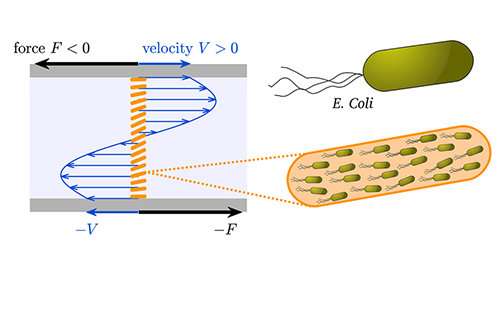Swimming bacteria work together to go with the flow

Swimming bacteria can reduce the viscosity of ordinary liquids like water and make them flow more easily, sometimes down to the point where the viscosity becomes zero: the flow is then frictionless.
Now researchers from the University of Bristol report that bacterial suspensions can have negative viscosity, a property strictly forbidden by the law of physics for ordinary fluids, but which becomes allowed when living organisms are present.
Viscosity is a fluid's resistance to flow. For example, oil does not flow as fast as water when poured out because its viscosity is larger. This opposition to motion is caused at the microscopic level by the friction between the fluid molecules.
Until recently, zero viscosity (also referred to as superfluidity) had only been seen in quantum systems at very low temperatures close to absolute zero. But a couple of years ago, zero viscosity was measured in suspensions of bacteria.
This is possible because bacteria are not like water molecules, they are alive or 'active'. By swimming together, they can generate forces in the fluid that are large enough to counterbalance friction, such that the bacterial suspension behaves as a superfluid.
"While this phenomenon has been observed experimentally, a detailed theory about how it works has been missing," says Dr. Aurore Loisy, Research Associate in Applied Mathematics & Theoretical Physics at the University of Bristol.
"Furthermore, a fundamental question was still open: can this phenomenon be pushed even further, so that the apparent viscosity becomes negative, meaning that the sheared bacterial fluid could actually do work rather than require work to be done on it to keep flowing, something which is impossible in passive or 'conventional' fluids?"
In their quest to unpack the concept of negative viscosity, Dr. Loisy and fellow researchers Tannie Liverpool, Professor of Theoretical Physics, and Jens Eggers, Professor of Applied Mathematics, studied how the self-organization and collective motion of microorganisms suspended in a fluid modify its hydrodynamic properties.
They showed that it is theoretically possible to make a suspension of bacteria behave as a negative viscosity fluid, and that this behaviour can be triggered and controlled by playing with the size of the container.
"This shows us that microscopic bacterial activity can be converted into macroscopic useful mechanical power. In other words, it is possible to make bacteria work together and use that to power larger devices," adds Dr. Loisy.
"It is important to note that we haven't got something for nothing, as in we've not broken the laws of thermodynamics. The bacteria are converting the nutrients they have ingested into mechanical work by swimming and the 'food for the bacteria' would be the fuel (source of the energy) of the putative machine.
"The next step is to observe this phenomenon experimentally, for example by turning a rheometer into a bacteria-powered rotary motor."
More information: Aurore Loisy et al. Active Suspensions have Nonmonotonic Flow Curves and Multiple Mechanical Equilibria, Physical Review Letters (2018). DOI: 10.1103/PhysRevLett.121.018001
Journal information: Physical Review Letters
Provided by University of Bristol





















